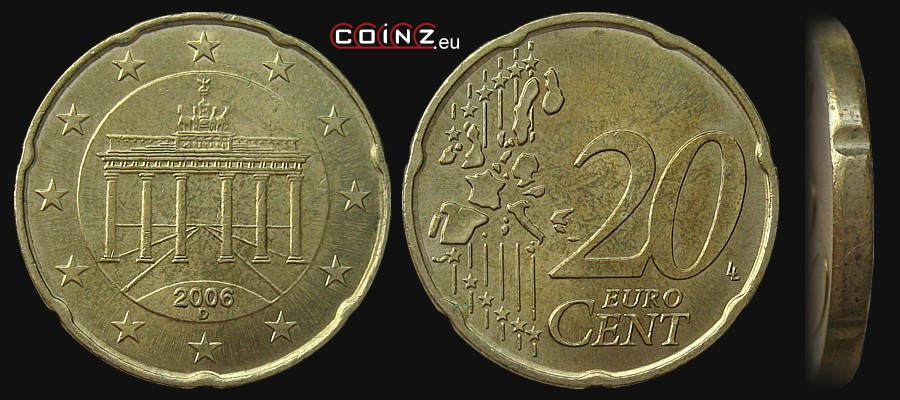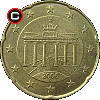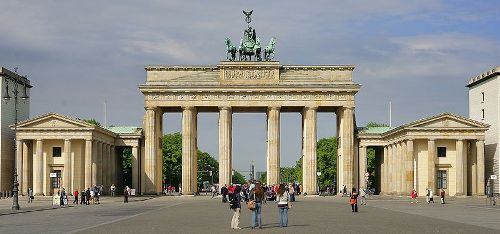20 euro cent GERMANY (2002-2006)


| diameter: | weight: | thickness: | alloy: |
| 22.25 mm | 5.74 g | 2.14 mm | Cu89Al5Zn5Sn1 (Nordic Gold) |
obverse:
in the centre in a disk the Brandenburg Gate; below year of issue; at the edge a ring of twelve five-pointed stars - symbol of the European Union
reverse:
right from the centre face value: 20, below in two lines: EURO / CENT; on the left a simplified map of Europe showing borders of countries - members of the EU in 1999; in the background of the map vertically six parallel lines ending on both sides with five-pointed stars (the reverse is common for all euro coins)
edge:
plain with seven indents (Spanish Flower)
issue date:
1 I 2002
withdrawal date:
circulating
designer:
Reinhard Heinsdorff, Luc Luycx (initials LL after 20 on the reverse)
mint:
(A) Staatliche Münze Berlin (The State Mint Berlin), Berlin;
(D) Bayerisches Hauptmünzamt (The Bavarian Main Mint), Munich;
(F) Staatliche Münzen Baden-Württemberg (State Mints of Baden-Wuerttemberg), Stuttgart;
(G) Staatliche Münzen Baden-Württemberg (State Mints of Baden-Wuerttemberg), Karlsruhe;
(J) Hamburgische Münze (The Hamburg Mint), Hamburg
(relevant mint mark below the year of issue in the obverse)
(D) Bayerisches Hauptmünzamt (The Bavarian Main Mint), Munich;
(F) Staatliche Münzen Baden-Württemberg (State Mints of Baden-Wuerttemberg), Stuttgart;
(G) Staatliche Münzen Baden-Württemberg (State Mints of Baden-Wuerttemberg), Karlsruhe;
(J) Hamburgische Münze (The Hamburg Mint), Hamburg
(relevant mint mark below the year of issue in the obverse)
mintage:
| A | D | F | G | J | |
| 2002 | 378 150 000 + 135 000 * |
367 000 000 + 135 000 * |
421 600 000 + 135 000 * |
251 900 000 + 135 000 * |
441 000 000 + 135 000 * |
| 2003 | 41 860 000 + 140 000 * |
24 100 000 + 140 000 * |
82 400 000 + 140 000 * |
42 100 000 + 140 000 * |
- + 140 000 * |
| 2004 | - + 140 000 * |
49 760 000 + 140 000 * |
- + 140 000 * |
- + 140 000 * |
- + 140 000 * |
| 2005 | 8 000 000 + 100 000 * |
8 400 000 + 100 000 * |
9 600 000 + 100 000 * |
5 600 000 + 100 000 * |
8 400 000 + 100 000 * |
| 2006 | 39 000 000 + 90 000 * |
40 950 000 + 90 000 * |
46 800 000 + 90 000 * |
27 300 000 + 90 000 * |
40 950 000 + 90 000 * |
| 2007 | - | - | ~ 200 000 | - | - |
interesting facts:
In 2007 in the State Mint Stuttgart a short serie of coins was by mistake struck using old reverse dies.
The Brandenburg Gate, the most famous city-gate of Berlin, was designed by Karl Gotthard Langhans and built in years 1788-1791. It was topped by a statue of Roman goddess Victory in a Quadriga. After world war II it was standing in a border zone between West Berlin and communistic German Democratic Republic, what made it inaccesible. Only the unification of Germany re-opened the gate for the common use. The Brandenburg Gate became thus the symbol of the united Germany.

photo: Cezary Piwowarski; licence: CC-BY-SA 3.0
The Brandenburg Gate, the most famous city-gate of Berlin, was designed by Karl Gotthard Langhans and built in years 1788-1791. It was topped by a statue of Roman goddess Victory in a Quadriga. After world war II it was standing in a border zone between West Berlin and communistic German Democratic Republic, what made it inaccesible. Only the unification of Germany re-opened the gate for the common use. The Brandenburg Gate became thus the symbol of the united Germany.

photo: Cezary Piwowarski; licence: CC-BY-SA 3.0
last update: 3 XII 2014
coins catalogue :: katalog monet :: münzkatalog :: catalogue de monnaies :: catálogo de monedas :: catalogo monete :: каталог монет :: κέρματα κατάλογος :: COINZ.eu
© 2010-2025 :: Adam Kubicki :: COINZ.eu :: All rights reserved.


